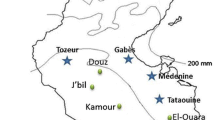Summary
Restriction fragment length polymorphism of the wheat nuclear ribosomal DNA has been studied in several steps of a breeding scheme, including parental genotypes, F1 hybrid, F9 generation, and anther-derived doubled haploid lines obtained from F9. Ribosomal DNA represents a suitable molecular marker in following segregation and possible divergency from expected homozygosity after haploidization of an androgenetic process. It has been shown to undergo variations among the first cycle-doubled haploid lines in the relative amount of two different sizes of ribosomal DNA repeat units. The specificity and peculiar properties of the plant system used allowed us to assign an intrachromosomal location (short arm of the chromosomes 1B, 1R or 6B) to several ribosomal DNA repeat units that differ by the length of their nontranscribed spacer region.
Similar content being viewed by others
References
Appels R, Dvorak J (1982) The wheat ribosomal DNA spacer region: its structure and variation in populations and among species. Theor Appl Genet 63:337–348
Brettell RIS, Pallotta MA, Gustavson JP, Appels R (1986) Variation at the Nor loci in triticale derived from tissue culture. Theor Appl Genet 71:637–643
Cullis CA (1981) Environmental induction of heritable changes in flax: defined environments inducing changes in rDNA and peroxidase isozyme band pattern. Heredity 47:87–94
De Buyser J, Henry Y, Laur R, Lonnet P (1981) Utilisation de l'androgenèse in vitro dans des programmes de sélection du blé tendre (Triticum aestivum L.). Z Pflanzenzücht 87:290–299
De Buyser J, Henry Y, Taleb G (1985) Wheat androgenesis: cytogenetical analysis and agronomic performance of doubled haploids. Z Pflanzenzücht 95:23–34
Dellaporta SL, Wood J, Hicks JB (1983) A plant DNA mini-preparation: version II. Plant Mol Biol Rep 1:19–21
Delseny M, Cooke R, Penon P (1983) Sequence heterogeneity in radish nuclear ribosomal RNA genes. Plant Sci Lett 30:107–119
Evans DA, Sharp WR, Medina-Filho HP (1984) Somaclonal and gametoclonal variation. Am J Bot 71:759–774
Flavell RB, Smith DD (1974) Variation in nucleolar rRNA gene multiplicity in wheat and rye. Chromosoma 47:327–334
Fodor I, Beridze T (1980) Structural organization of plant ribosomal DNA. Biochem Intern 1:493–501
Gerlach WL, Bedbrook JR (1979) Cloning and characterization of ribosomal RNA genes from wheat and barley. Nucleic Acids Res 7:1869–1885
Henry Y, De Buyser J (1985) Effect of the 1B/1R translocation on anther culture ability in wheat (Triticum aestivum L.). Plant Cell Rep 4:307–310
Kato A, Yakura K, Tanifuji S (1982) Organization of ribosomal DNA in the carrot. Plant Cell Physiol 23:151–154
Landsmann J, Uhrig H (1985) Somaclonal variation in Solanum tuberosum detected at the molecular level. Theor Appl Genet 71:500–505
Larkin PJ, Scowcroft LVR (1981) Somaclonal variation, a novel source of variability from cell cultures for plant improvement. Theor Appl Genet 60:197–214
Maggini F, Barsanti P, Marazia T (1978) Individual variation of the nucleolus organizer regions in Alium cepa and A. sativum. Chromosoma 66:173–183
Mettin D, Blüthner WD, Schlegel G (1976) Proc 4th Int Wheat Genet Symp, Mo Agric Exp Stn, Columbia, pp 179–184
Miller TE (1984) The homeologous relationship between the chromosomes of rye and wheat. Current status. Can J Genet Cytol 26:578–589
Oono K, Sugiura M (1980) Heterogeneity of the ribosomal RNA gene clusters in rice. Chromosoma 76:85–89
Paepe R de, Prat D, Huguet T (1982) Heritable nuclear DNA changes in doubled haploid plants obtained by pollen culture of Nicotiana sylvestris. Plant Sci Lett 28:11–28
Rivin CJ, Zimmer EA, Cullis CA, Walbot V, Huynh T, Davis RW (1983) Evaluation of genomic variability at the nucleic acid level. Plant Mol Biol Rep 1:9–16
Rode A, Hartmann C, Benslimane A, Picard E, Quétier F (1987) Gametoclonal variation detected in the nuclear ribosomal DNA from doubled haploid lines of a spring wheat (Triticum aestivum L., cv César). Theor Appl Genet 74:31–37
Uchimiya H, Ohgawara T, Kato H, Akiyama T, Harada H (1983) Detection of two different nuclear genomes in parasexual hybrids by ribosomal RNA gene analysis. Theor Appl Genet 64:117–118
Varsanyi-Breiner A, Gusella JF, Keys C, Housman DE (1979) The organization of a nuclear DNA sequence from a higher plant: molecular cloning and characterization of soybean ribosomal DNA. Gene 7:317–334
Yakura K, Kato A, Tanifuji S (1984) Length heterogeneity of the large spacer of Vicia faba rDNA is due to the differing number of a 325 bp repetitive sequence element. Mol Gen Genet 193:400–405
Author information
Authors and Affiliations
Additional information
Communicated by P. Maliga
Rights and permissions
About this article
Cite this article
Benslimane, A., Hartmann, C., de Buyse, J. et al. Ribosomal DNA as a convenient probe to follow segregation and possible divergency from expected homozygosity after haploidization of an androgenetic process. Theoret. Appl. Genetics 75, 389–396 (1988). https://doi.org/10.1007/BF00276740
Received:
Accepted:
Issue Date:
DOI: https://doi.org/10.1007/BF00276740




